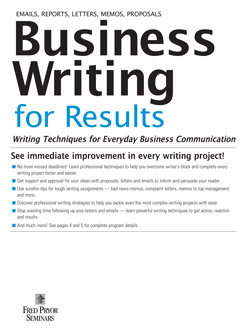Proofreading Hacks: From Sloppy to Superb
Business writing is an important work activity, and effectively proofreading a document can be the difference between sloppy and superb. Here are some hacks for doing it well:
- Find and Replace Slang. The term “hack,” for example, is great for a blog. Not so great for business correspondence. Check your work for slang words and replace.
- Avoid “Graveyard Words.” These are words without real precision and meaning – they include get, really, some, stuff and very. For example, “He got some really important stuff done” is not preferred Business English. Instead: “He completed an important report.”
- Check Tenses. Events that occurred in the past should be in past tense. General knowledge and facts should be in the present tense. Check for consistency and clarity throughout the document.
- Spell Check. Word processors almost universally have spell-checkers in them. Use them!
- Don’t Trust Spellcheck! In an earlier draft of this article, the spellchecker auto-corrected a misspelling of “precision” to be “processing.” Spellcheck is not enough – you need to read it!
- Use Grammar Check Tools Judiciously. Many word processors have a grammar check function as well as spell check. Use it to identify possible problems and trust your judgement. They aren’t perfect yet.
- Know Your Organization’s Preferences. My organization LOVES the “Oxford comma (“A, B, and C” NOT A, B and C”). Yours may not. If your organization has a preferred style and grammar guide, use it.
- Read Aloud. Newer versions of Microsoft® Word have a “Read Aloud” button under the “Review” tab. Really listening to someone read your writing back to you helps catch grammar problems that your eye won’t catch. And the computer reader doesn’t judge, so it is a safe way to check your work.
- Peer Review. When possible, peer reviews can be a great way to catch errors – someone new to your work will catch problems you don’t.
Proofreading is an important part of writing and can be the difference between a “piece of art” and a “peace of air.” Let’s get started.







